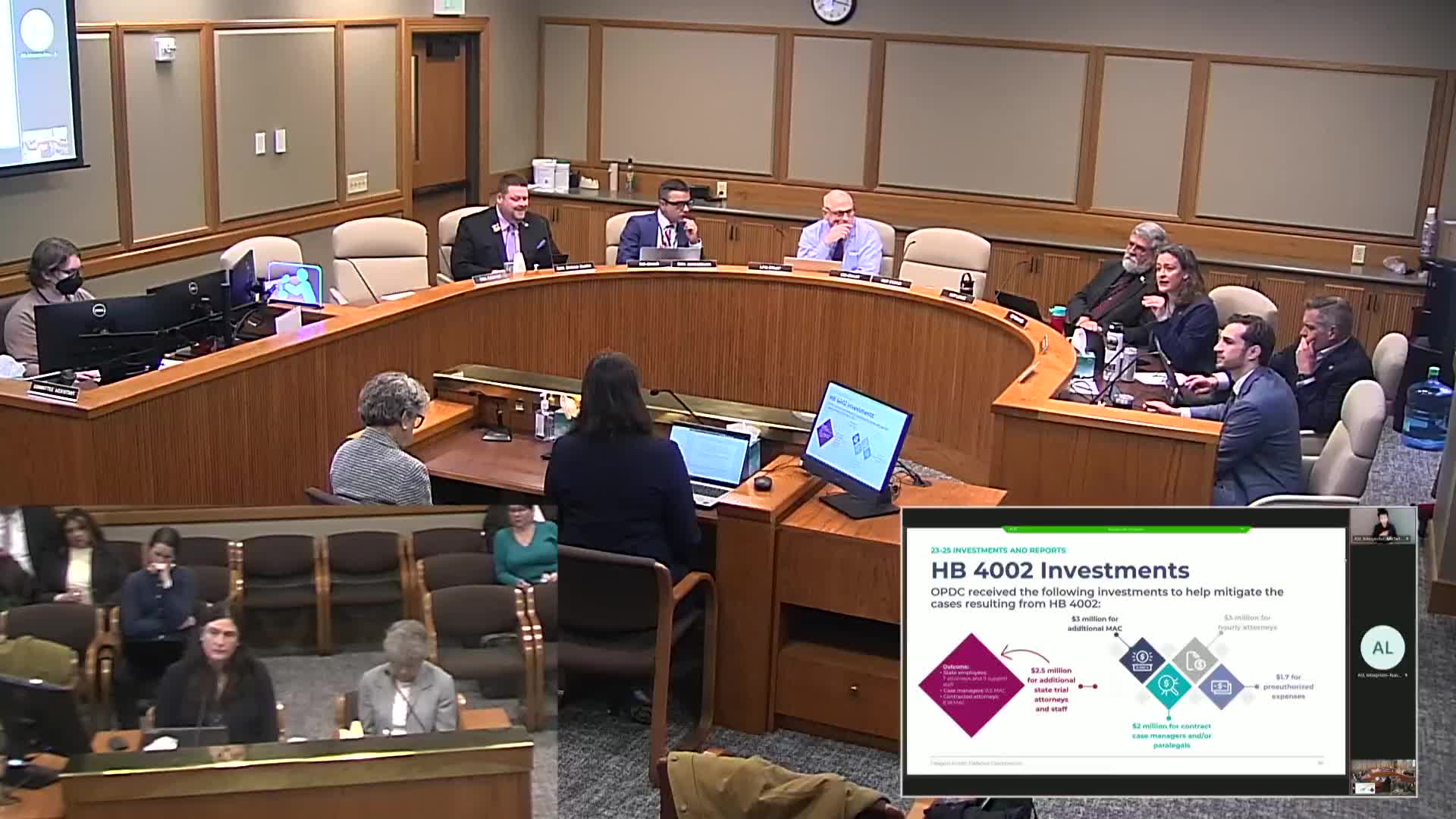Oregon Public Defense Commission improves case load forecasting methods under Senate Bill 337
March 18, 2025 | Public Safety, Ways and Means, Joint, Committees, Legislative, Oregon
This article was created by AI summarizing key points discussed. AI makes mistakes, so for full details and context, please refer to the video of the full meeting. Please report any errors so we can fix them. Report an error »

The Joint Committee on Ways and Means Subcommittee on Public Safety convened on March 18, 2025, to discuss critical issues surrounding public defense funding and case management in Oregon. The meeting highlighted the ongoing challenges faced by public defenders and the implications of recent legislative changes on the state's legal system.
A significant focus of the discussion was the impact of House Bill 4002, which allocated funds aimed at reducing the number of cases handled by public defenders. Representatives expressed a need for data to assess whether this funding has effectively mitigated case loads. Co-Chair Bridal and Representative Lewis emphasized the importance of understanding the correlation between the influx of financial resources and trends in case management. The committee requested supplemental information to clarify these impacts, indicating a proactive approach to evaluating legislative effectiveness.
The meeting also addressed the Oregon Public Defense Commission's new forecasting methods for public defense caseloads, which have shifted from an in-house process to collaboration with the Department of Administrative Services' Office of Economic Analysis. This change aims to enhance the accuracy of projections regarding the number of cases public defenders will manage in the upcoming biennium. However, concerns were raised about the limitations of these forecasts, particularly regarding unrepresented individuals and ongoing cases that are not accounted for in the projections.
Representatives questioned why the forecast does not include the approximately 30,000 open cases that public defenders are currently managing, as well as the ethical considerations that may prevent attorneys from taking on maximum case loads. These discussions underscored the complexities of accurately predicting public defense needs and the potential gaps in service that could arise from the current forecasting model.
In conclusion, the meeting revealed a critical intersection of funding, case management, and ethical considerations within Oregon's public defense system. As the committee seeks to gather more data and refine its forecasting methods, the implications of these discussions will likely resonate throughout the state's legal landscape, impacting both the efficiency of public defense services and the rights of individuals navigating the justice system. The committee plans to reconvene to further explore these issues, emphasizing the ongoing need for transparency and accountability in public defense funding and operations.
A significant focus of the discussion was the impact of House Bill 4002, which allocated funds aimed at reducing the number of cases handled by public defenders. Representatives expressed a need for data to assess whether this funding has effectively mitigated case loads. Co-Chair Bridal and Representative Lewis emphasized the importance of understanding the correlation between the influx of financial resources and trends in case management. The committee requested supplemental information to clarify these impacts, indicating a proactive approach to evaluating legislative effectiveness.
The meeting also addressed the Oregon Public Defense Commission's new forecasting methods for public defense caseloads, which have shifted from an in-house process to collaboration with the Department of Administrative Services' Office of Economic Analysis. This change aims to enhance the accuracy of projections regarding the number of cases public defenders will manage in the upcoming biennium. However, concerns were raised about the limitations of these forecasts, particularly regarding unrepresented individuals and ongoing cases that are not accounted for in the projections.
Representatives questioned why the forecast does not include the approximately 30,000 open cases that public defenders are currently managing, as well as the ethical considerations that may prevent attorneys from taking on maximum case loads. These discussions underscored the complexities of accurately predicting public defense needs and the potential gaps in service that could arise from the current forecasting model.
In conclusion, the meeting revealed a critical intersection of funding, case management, and ethical considerations within Oregon's public defense system. As the committee seeks to gather more data and refine its forecasting methods, the implications of these discussions will likely resonate throughout the state's legal landscape, impacting both the efficiency of public defense services and the rights of individuals navigating the justice system. The committee plans to reconvene to further explore these issues, emphasizing the ongoing need for transparency and accountability in public defense funding and operations.
View full meeting
This article is based on a recent meeting—watch the full video and explore the complete transcript for deeper insights into the discussion.
View full meeting
